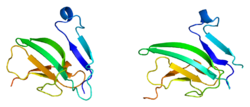ACVR2A
El receptor de activina tipo 2A es una proteína que en humanos está codificada por el gen ACVR2A .[3][4][5] ACVR2A es un receptor de activina tipo 2 .
Función
editarEste gen codifica el receptor de activina A tipo II. Las activinas son factores diméricos de crecimiento y diferenciación que pertenecen a la superfamilia del factor de crecimiento transformante beta (TGF-beta) de proteínas de señalización relacionadas estructuralmente. Las activinas señalizan a través de un complejo heteromérico de serina quinasas receptoras que incluyen al menos dos receptores de tipo I (I y IB) y dos de tipo II (II y IIB). Todos estos receptores son proteínas transmembrana, compuestas por un dominio extracelular de unión a ligando con región rica en cisteína, un dominio transmembrana y un dominio citoplásmico con especificidad de serina / treonina predicha. Los receptores de tipo I son esenciales para la señalización; y los receptores de tipo II son necesarios para unir ligandos y para la expresión de receptores de tipo I. Los receptores de tipo I y II forman un complejo estable después de la unión del ligando, lo que resulta en la fosforilación de los receptores de tipo I por los receptores de tipo II. Los receptores de tipo II se consideran quinasas constitutivamente activas.[5]
Interacciones
editarSe ha demostrado que ACVR2A interactúa con:
Referencias
editar- ↑ «Human PubMed Reference:».
- ↑ «Mouse PubMed Reference:».
- ↑ «Molecular cloning and binding properties of the human type II activin receptor». Biochem. Biophys. Res. Commun. 184 (1): 310-6. May 1992. PMID 1314589. doi:10.1016/0006-291X(92)91194-U.
- ↑ «Assignment of ACVR2 and ACVR2B the human activin receptor type II and IIB genes to chromosome bands 2q22.2-->q23.3 and 3p22 and the human follistatin gene (FST) to chromosome 5q11.2 by FISH». Cytogenet. Cell Genet. 87 (3–4): 219-20. April 2000. PMID 10702675. doi:10.1159/000015429.
- ↑ a b «Entrez Gene: ACVR2A activin A receptor, type IIA».
- ↑ «Roles of pathway-specific and inhibitory Smads in activin receptor signaling». Mol. Endocrinol. 13 (1): 15-23. January 1999. PMID 9892009. doi:10.1210/mend.13.1.0218.
- ↑ «Truncated activin type II receptors inhibit bioactivity by the formation of heteromeric complexes with activin type I. receptors». Exp. Cell Res. 224 (2): 323-34. May 1996. PMID 8612709. doi:10.1006/excr.1996.0142.
- ↑ «Betaglycan binds inhibin and can mediate functional antagonism of activin signalling». Nature 404 (6776): 411-4. March 2000. Bibcode:2000Natur.404..411L. PMID 10746731. doi:10.1038/35006129.
- ↑ «Inhibin interferes with activin signaling at the level of the activin receptor complex in Chinese hamster ovary cells». Endocrinology 138 (7): 2928-36. July 1997. PMID 9202237. doi:10.1210/endo.138.7.5250.
- ↑ «Novel factors in regulation of activin signaling». Mol. Cell. Endocrinol. 225 (1–2): 1-8. October 2004. PMID 15451561. doi:10.1016/j.mce.2004.02.006.
- ↑ «Regulation of endocytosis of activin type II receptors by a novel PDZ protein through Ral/Ral-binding protein 1-dependent pathway». J. Biol. Chem. 277 (21): 19008-18. May 2002. PMID 11882656. doi:10.1074/jbc.M112472200.
